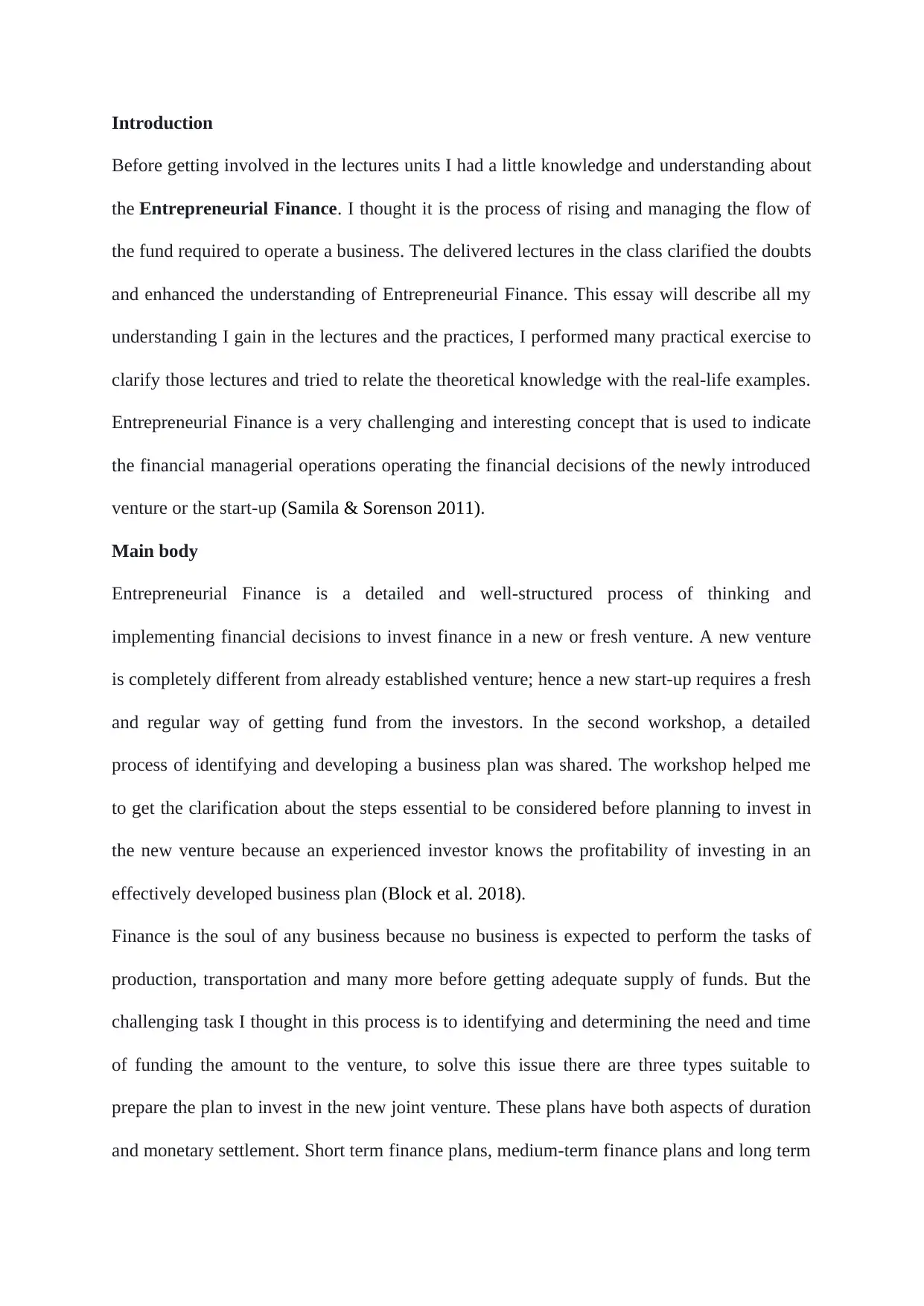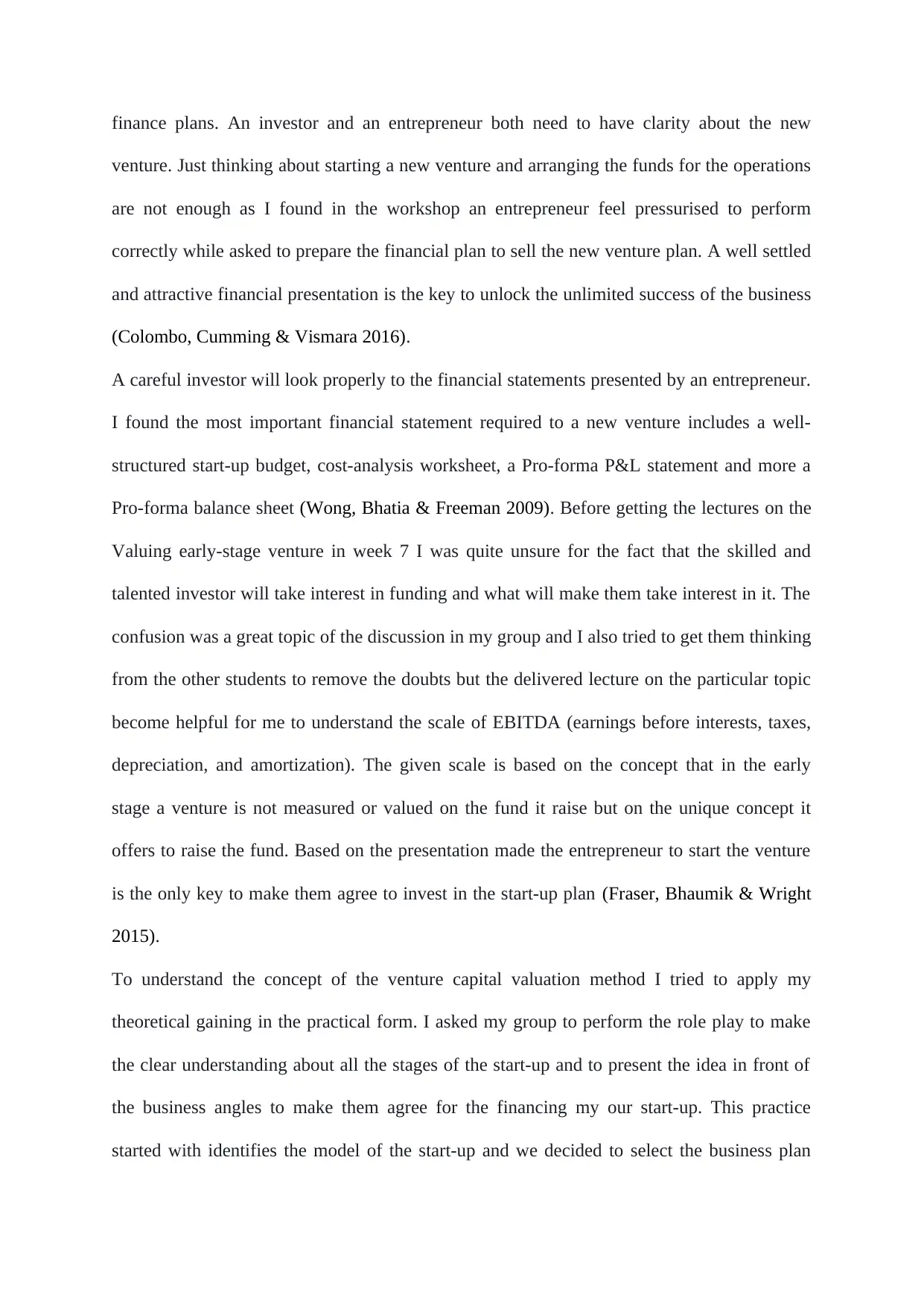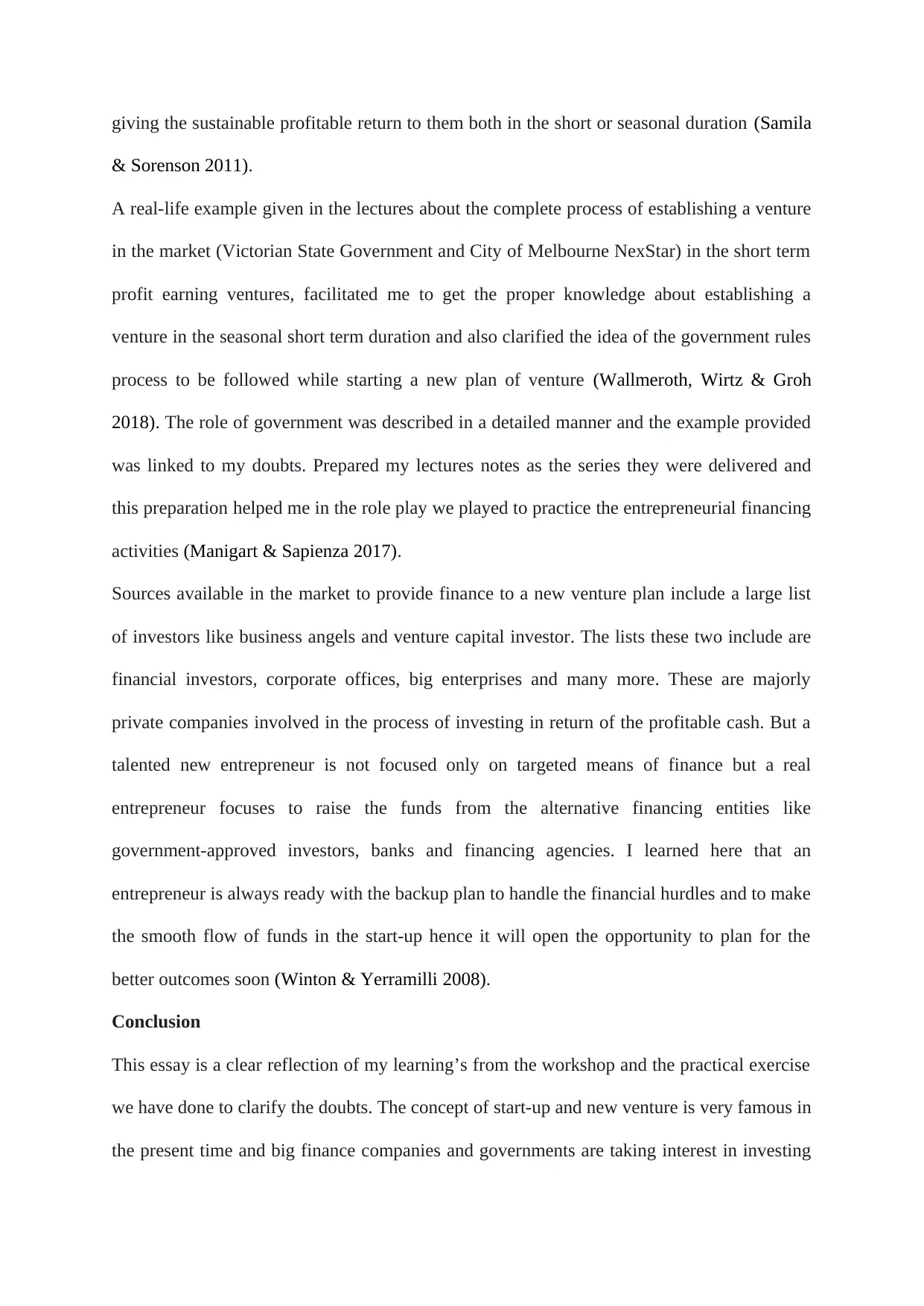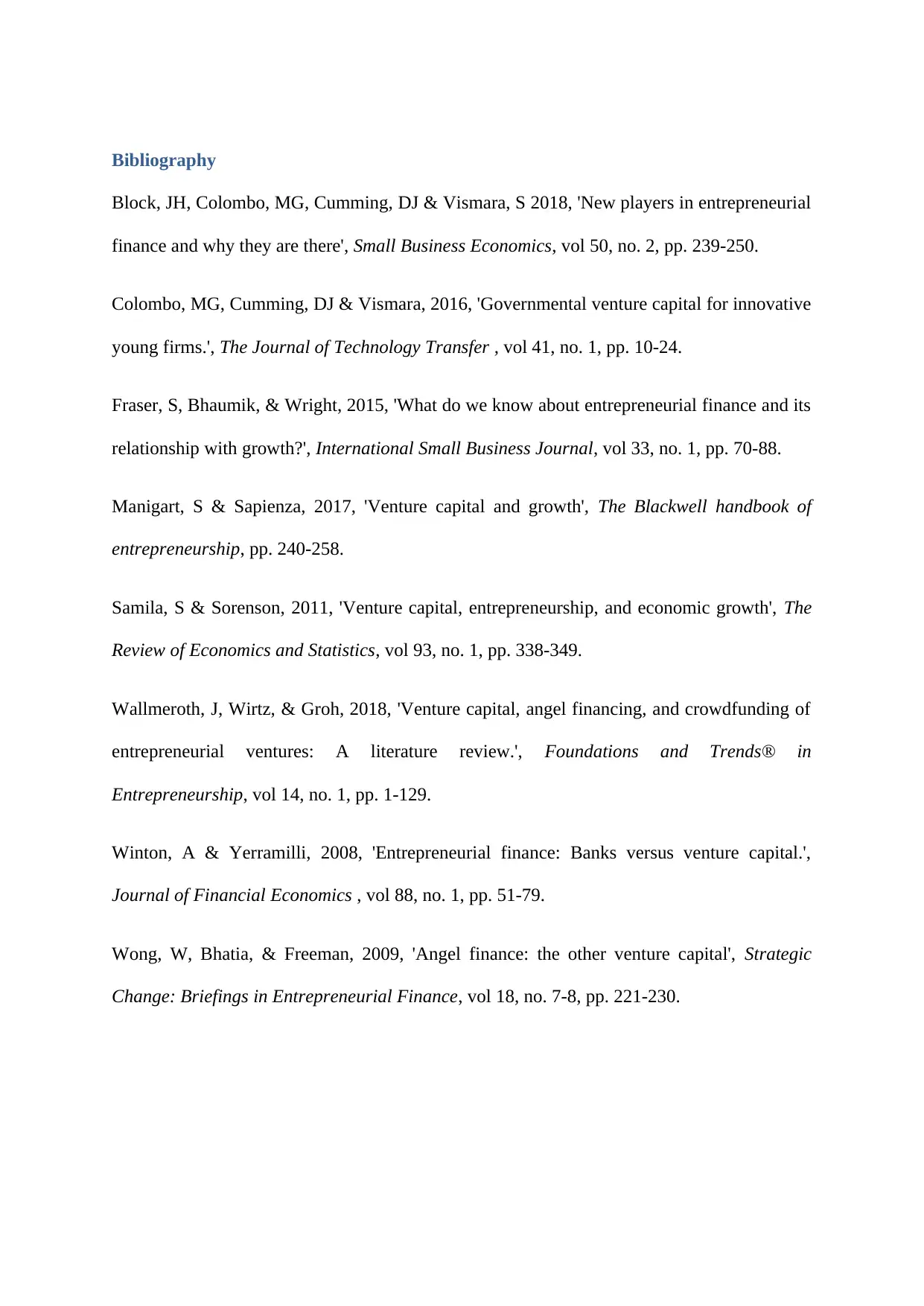Semester 2, 2019: Entrepreneurial Finance Personal Reflection
VerifiedAdded on 2022/10/07
|7
|1489
|31
Essay
AI Summary
This essay provides a comprehensive reflection on the student's learning journey in the BAFN306 Entrepreneurial Finance unit. The essay begins by outlining the student's initial understanding of entrepreneurial finance before the course, which primarily involved the process of raising and managing funds for a business. Through lectures and workshops, the student gained a deeper understanding of key concepts, including the importance of a well-developed business plan, the different types of financing (short, medium, and long-term), and the significance of financial statements like start-up budgets and pro-forma statements. The essay details practical exercises, such as role-playing scenarios, that helped solidify the theoretical knowledge. The student also explores the concept of valuing early-stage ventures, the role of government in supporting new ventures, and the various sources of finance available to entrepreneurs, including business angels and venture capital investors. The reflection concludes with the student's enhanced understanding of the entrepreneurial finance process and its importance for both new and established businesses.

Entrepreneurial Financing
Paraphrase This Document
Need a fresh take? Get an instant paraphrase of this document with our AI Paraphraser

Introduction
Before getting involved in the lectures units I had a little knowledge and understanding about
the Entrepreneurial Finance. I thought it is the process of rising and managing the flow of
the fund required to operate a business. The delivered lectures in the class clarified the doubts
and enhanced the understanding of Entrepreneurial Finance. This essay will describe all my
understanding I gain in the lectures and the practices, I performed many practical exercise to
clarify those lectures and tried to relate the theoretical knowledge with the real-life examples.
Entrepreneurial Finance is a very challenging and interesting concept that is used to indicate
the financial managerial operations operating the financial decisions of the newly introduced
venture or the start-up (Samila & Sorenson 2011).
Main body
Entrepreneurial Finance is a detailed and well-structured process of thinking and
implementing financial decisions to invest finance in a new or fresh venture. A new venture
is completely different from already established venture; hence a new start-up requires a fresh
and regular way of getting fund from the investors. In the second workshop, a detailed
process of identifying and developing a business plan was shared. The workshop helped me
to get the clarification about the steps essential to be considered before planning to invest in
the new venture because an experienced investor knows the profitability of investing in an
effectively developed business plan (Block et al. 2018).
Finance is the soul of any business because no business is expected to perform the tasks of
production, transportation and many more before getting adequate supply of funds. But the
challenging task I thought in this process is to identifying and determining the need and time
of funding the amount to the venture, to solve this issue there are three types suitable to
prepare the plan to invest in the new joint venture. These plans have both aspects of duration
and monetary settlement. Short term finance plans, medium-term finance plans and long term
Before getting involved in the lectures units I had a little knowledge and understanding about
the Entrepreneurial Finance. I thought it is the process of rising and managing the flow of
the fund required to operate a business. The delivered lectures in the class clarified the doubts
and enhanced the understanding of Entrepreneurial Finance. This essay will describe all my
understanding I gain in the lectures and the practices, I performed many practical exercise to
clarify those lectures and tried to relate the theoretical knowledge with the real-life examples.
Entrepreneurial Finance is a very challenging and interesting concept that is used to indicate
the financial managerial operations operating the financial decisions of the newly introduced
venture or the start-up (Samila & Sorenson 2011).
Main body
Entrepreneurial Finance is a detailed and well-structured process of thinking and
implementing financial decisions to invest finance in a new or fresh venture. A new venture
is completely different from already established venture; hence a new start-up requires a fresh
and regular way of getting fund from the investors. In the second workshop, a detailed
process of identifying and developing a business plan was shared. The workshop helped me
to get the clarification about the steps essential to be considered before planning to invest in
the new venture because an experienced investor knows the profitability of investing in an
effectively developed business plan (Block et al. 2018).
Finance is the soul of any business because no business is expected to perform the tasks of
production, transportation and many more before getting adequate supply of funds. But the
challenging task I thought in this process is to identifying and determining the need and time
of funding the amount to the venture, to solve this issue there are three types suitable to
prepare the plan to invest in the new joint venture. These plans have both aspects of duration
and monetary settlement. Short term finance plans, medium-term finance plans and long term

finance plans. An investor and an entrepreneur both need to have clarity about the new
venture. Just thinking about starting a new venture and arranging the funds for the operations
are not enough as I found in the workshop an entrepreneur feel pressurised to perform
correctly while asked to prepare the financial plan to sell the new venture plan. A well settled
and attractive financial presentation is the key to unlock the unlimited success of the business
(Colombo, Cumming & Vismara 2016).
A careful investor will look properly to the financial statements presented by an entrepreneur.
I found the most important financial statement required to a new venture includes a well-
structured start-up budget, cost-analysis worksheet, a Pro-forma P&L statement and more a
Pro-forma balance sheet (Wong, Bhatia & Freeman 2009). Before getting the lectures on the
Valuing early-stage venture in week 7 I was quite unsure for the fact that the skilled and
talented investor will take interest in funding and what will make them take interest in it. The
confusion was a great topic of the discussion in my group and I also tried to get them thinking
from the other students to remove the doubts but the delivered lecture on the particular topic
become helpful for me to understand the scale of EBITDA (earnings before interests, taxes,
depreciation, and amortization). The given scale is based on the concept that in the early
stage a venture is not measured or valued on the fund it raise but on the unique concept it
offers to raise the fund. Based on the presentation made the entrepreneur to start the venture
is the only key to make them agree to invest in the start-up plan (Fraser, Bhaumik & Wright
2015).
To understand the concept of the venture capital valuation method I tried to apply my
theoretical gaining in the practical form. I asked my group to perform the role play to make
the clear understanding about all the stages of the start-up and to present the idea in front of
the business angles to make them agree for the financing my our start-up. This practice
started with identifies the model of the start-up and we decided to select the business plan
venture. Just thinking about starting a new venture and arranging the funds for the operations
are not enough as I found in the workshop an entrepreneur feel pressurised to perform
correctly while asked to prepare the financial plan to sell the new venture plan. A well settled
and attractive financial presentation is the key to unlock the unlimited success of the business
(Colombo, Cumming & Vismara 2016).
A careful investor will look properly to the financial statements presented by an entrepreneur.
I found the most important financial statement required to a new venture includes a well-
structured start-up budget, cost-analysis worksheet, a Pro-forma P&L statement and more a
Pro-forma balance sheet (Wong, Bhatia & Freeman 2009). Before getting the lectures on the
Valuing early-stage venture in week 7 I was quite unsure for the fact that the skilled and
talented investor will take interest in funding and what will make them take interest in it. The
confusion was a great topic of the discussion in my group and I also tried to get them thinking
from the other students to remove the doubts but the delivered lecture on the particular topic
become helpful for me to understand the scale of EBITDA (earnings before interests, taxes,
depreciation, and amortization). The given scale is based on the concept that in the early
stage a venture is not measured or valued on the fund it raise but on the unique concept it
offers to raise the fund. Based on the presentation made the entrepreneur to start the venture
is the only key to make them agree to invest in the start-up plan (Fraser, Bhaumik & Wright
2015).
To understand the concept of the venture capital valuation method I tried to apply my
theoretical gaining in the practical form. I asked my group to perform the role play to make
the clear understanding about all the stages of the start-up and to present the idea in front of
the business angles to make them agree for the financing my our start-up. This practice
started with identifies the model of the start-up and we decided to select the business plan
⊘ This is a preview!⊘
Do you want full access?
Subscribe today to unlock all pages.

Trusted by 1+ million students worldwide

giving the sustainable profitable return to them both in the short or seasonal duration (Samila
& Sorenson 2011).
A real-life example given in the lectures about the complete process of establishing a venture
in the market (Victorian State Government and City of Melbourne NexStar) in the short term
profit earning ventures, facilitated me to get the proper knowledge about establishing a
venture in the seasonal short term duration and also clarified the idea of the government rules
process to be followed while starting a new plan of venture (Wallmeroth, Wirtz & Groh
2018). The role of government was described in a detailed manner and the example provided
was linked to my doubts. Prepared my lectures notes as the series they were delivered and
this preparation helped me in the role play we played to practice the entrepreneurial financing
activities (Manigart & Sapienza 2017).
Sources available in the market to provide finance to a new venture plan include a large list
of investors like business angels and venture capital investor. The lists these two include are
financial investors, corporate offices, big enterprises and many more. These are majorly
private companies involved in the process of investing in return of the profitable cash. But a
talented new entrepreneur is not focused only on targeted means of finance but a real
entrepreneur focuses to raise the funds from the alternative financing entities like
government-approved investors, banks and financing agencies. I learned here that an
entrepreneur is always ready with the backup plan to handle the financial hurdles and to make
the smooth flow of funds in the start-up hence it will open the opportunity to plan for the
better outcomes soon (Winton & Yerramilli 2008).
Conclusion
This essay is a clear reflection of my learning’s from the workshop and the practical exercise
we have done to clarify the doubts. The concept of start-up and new venture is very famous in
the present time and big finance companies and governments are taking interest in investing
& Sorenson 2011).
A real-life example given in the lectures about the complete process of establishing a venture
in the market (Victorian State Government and City of Melbourne NexStar) in the short term
profit earning ventures, facilitated me to get the proper knowledge about establishing a
venture in the seasonal short term duration and also clarified the idea of the government rules
process to be followed while starting a new plan of venture (Wallmeroth, Wirtz & Groh
2018). The role of government was described in a detailed manner and the example provided
was linked to my doubts. Prepared my lectures notes as the series they were delivered and
this preparation helped me in the role play we played to practice the entrepreneurial financing
activities (Manigart & Sapienza 2017).
Sources available in the market to provide finance to a new venture plan include a large list
of investors like business angels and venture capital investor. The lists these two include are
financial investors, corporate offices, big enterprises and many more. These are majorly
private companies involved in the process of investing in return of the profitable cash. But a
talented new entrepreneur is not focused only on targeted means of finance but a real
entrepreneur focuses to raise the funds from the alternative financing entities like
government-approved investors, banks and financing agencies. I learned here that an
entrepreneur is always ready with the backup plan to handle the financial hurdles and to make
the smooth flow of funds in the start-up hence it will open the opportunity to plan for the
better outcomes soon (Winton & Yerramilli 2008).
Conclusion
This essay is a clear reflection of my learning’s from the workshop and the practical exercise
we have done to clarify the doubts. The concept of start-up and new venture is very famous in
the present time and big finance companies and governments are taking interest in investing
Paraphrase This Document
Need a fresh take? Get an instant paraphrase of this document with our AI Paraphraser

new ideas to develop the economy of a nation. Financing is the most important factor in any
business whether it is running or new. But for a new venture, it is quite difficult to arrange the
funds to start a business. This essay has a detailed analysis of the process of planning to start
a business, to prepare the financial statement and to deliver a profitable outcome to the
investor.
business whether it is running or new. But for a new venture, it is quite difficult to arrange the
funds to start a business. This essay has a detailed analysis of the process of planning to start
a business, to prepare the financial statement and to deliver a profitable outcome to the
investor.

Bibliography
Block, JH, Colombo, MG, Cumming, DJ & Vismara, S 2018, 'New players in entrepreneurial
finance and why they are there', Small Business Economics, vol 50, no. 2, pp. 239-250.
Colombo, MG, Cumming, DJ & Vismara, 2016, 'Governmental venture capital for innovative
young firms.', The Journal of Technology Transfer , vol 41, no. 1, pp. 10-24.
Fraser, S, Bhaumik, & Wright, 2015, 'What do we know about entrepreneurial finance and its
relationship with growth?', International Small Business Journal, vol 33, no. 1, pp. 70-88.
Manigart, S & Sapienza, 2017, 'Venture capital and growth', The Blackwell handbook of
entrepreneurship, pp. 240-258.
Samila, S & Sorenson, 2011, 'Venture capital, entrepreneurship, and economic growth', The
Review of Economics and Statistics, vol 93, no. 1, pp. 338-349.
Wallmeroth, J, Wirtz, & Groh, 2018, 'Venture capital, angel financing, and crowdfunding of
entrepreneurial ventures: A literature review.', Foundations and Trends® in
Entrepreneurship, vol 14, no. 1, pp. 1-129.
Winton, A & Yerramilli, 2008, 'Entrepreneurial finance: Banks versus venture capital.',
Journal of Financial Economics , vol 88, no. 1, pp. 51-79.
Wong, W, Bhatia, & Freeman, 2009, 'Angel finance: the other venture capital', Strategic
Change: Briefings in Entrepreneurial Finance, vol 18, no. 7-8, pp. 221-230.
Block, JH, Colombo, MG, Cumming, DJ & Vismara, S 2018, 'New players in entrepreneurial
finance and why they are there', Small Business Economics, vol 50, no. 2, pp. 239-250.
Colombo, MG, Cumming, DJ & Vismara, 2016, 'Governmental venture capital for innovative
young firms.', The Journal of Technology Transfer , vol 41, no. 1, pp. 10-24.
Fraser, S, Bhaumik, & Wright, 2015, 'What do we know about entrepreneurial finance and its
relationship with growth?', International Small Business Journal, vol 33, no. 1, pp. 70-88.
Manigart, S & Sapienza, 2017, 'Venture capital and growth', The Blackwell handbook of
entrepreneurship, pp. 240-258.
Samila, S & Sorenson, 2011, 'Venture capital, entrepreneurship, and economic growth', The
Review of Economics and Statistics, vol 93, no. 1, pp. 338-349.
Wallmeroth, J, Wirtz, & Groh, 2018, 'Venture capital, angel financing, and crowdfunding of
entrepreneurial ventures: A literature review.', Foundations and Trends® in
Entrepreneurship, vol 14, no. 1, pp. 1-129.
Winton, A & Yerramilli, 2008, 'Entrepreneurial finance: Banks versus venture capital.',
Journal of Financial Economics , vol 88, no. 1, pp. 51-79.
Wong, W, Bhatia, & Freeman, 2009, 'Angel finance: the other venture capital', Strategic
Change: Briefings in Entrepreneurial Finance, vol 18, no. 7-8, pp. 221-230.
⊘ This is a preview!⊘
Do you want full access?
Subscribe today to unlock all pages.

Trusted by 1+ million students worldwide

1 out of 7
Related Documents
Your All-in-One AI-Powered Toolkit for Academic Success.
+13062052269
info@desklib.com
Available 24*7 on WhatsApp / Email
![[object Object]](/_next/static/media/star-bottom.7253800d.svg)
Unlock your academic potential
Copyright © 2020–2025 A2Z Services. All Rights Reserved. Developed and managed by ZUCOL.





